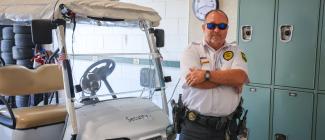If You See Something, Say Something!
Suspicious Activity
Suspicious activity is any observed behavior that could indicate terrorism or terrorism-related crime. This includes, but is not limited to:
- Unusual items or situations: A vehicle is parked in an odd location, a package/luggage is unattended, a window/door is open that is usually closed, or other out-of-the-ordinary situations occur.
- Eliciting information: A person questions individuals at a level beyond curiosity about a building’s purpose, operations, security procedures and/or personnel, shift changes, etc.
- Observation/surveillance: Someone pays unusual attention to facilities or buildings beyond a casual or professional interest. This includes extended loitering without explanation (particularly in concealed locations); unusual, repeated, and/or prolonged observation of a building (e.g., with binoculars or video camera); taking notes or measurements; counting paces; sketching floor plans, etc.
Some of these activities could be innocent—it's up to law enforcement to determine whether the behavior warrants investigation. The activities above are not all-inclusive, but have been compiled based on studies of pre-operational aspects of both successful and thwarted terrorist events over several years. Source: U.S. Department of Homeland Security.
Awareness
- Be aware of your surroundings and take the proper precautions to help ensure your personal safety. Keep your personal belongings in sight or in a secure location. Park in designated areas and lock your vehicle if left unattended. In secluded areas, be sure to walk with a friend.
- Prevention of any crime begins with awareness. Become aware of your surroundings and stay tuned in for possible danger or threats to your safety.
Plan Ahead
- Be wary and suspicious of observed behavior or activities that make you feel uncomfortable and avoid secluded places where you are put in a vulnerable position.
- Trust your instincts.
- If someone or something appears troublesome, leave the area and contact law enforcement.
When Walking
- Stay in well-lighted areas, away from alleys, bushes, and entryways.
- Minimize distractions. Even if you are talking on a cell phone or listening to music, lower the volume, keep your head up, and frequently look around.
- Always try to let someone know where you are going and when you expect to return.
- If a driver stops to ask directions, avoid getting close to the car, and only accept rides from people you know well.
- If a car appears to be following you, turn and walk in the opposite direction. After you have safely cleared the area, contact law enforcement.
Traveling in Your Car
- Have your keys ready when you approach your vehicle and check inside before entering, including the back seat. Lock your doors. Avoid isolated roads and shortcuts and park in well-lighted areas. If you are followed, drive to the nearest open business for help, or go to a police or fire station.

